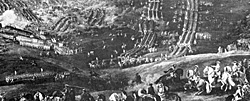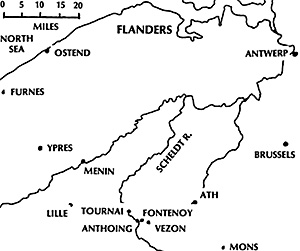 FONTENOY: British and Hanoverian infantry attacked by French cavalry. (Painted by Van Blarenberghe. The Musee de Versailles.)
FONTENOY: British and Hanoverian infantry attacked by French cavalry. (Painted by Van Blarenberghe. The Musee de Versailles.)
The Battle of Fontenoy (1745) is, in many ways, the watershed battle of France's Ancien Regime, and perhaps one of the greatest in history.
The battle revealed the latent, and some all too obvious, defects of the once great French military machine. The army had not advanced since the early days of Louis XIV, and triumphed primarily because of the generalship of France's great captain, Maurice de Saxe. Without a cle Saxe the French experienced a steady decline ending in the disaster of the Seven Years War.
THE CAMPAIGN
The War of the Austrian Succession lasted from 1740 to 1748. Upon the death of Emperor Charles V1 of Austria in 1740, his daughter, Maria Theresa laid claim to the imperial throne by virtue of a document known as the Pragmatic Sanction. Her claim was challenged by Bavaria's Elector, Charles Albert, who sought the throne himself. Charles had the strong support of France.
At the same time, King Frederick II ("the Great") of Prussia invaded Silesia, asserting his claim to that eastern Austrian province. In 1742, Austria had made temporary peace with Frederick and had driven the French back to Bavaria. Seeing which way fortune was swinging and fearing for his own Hanover, George II threw his support to Austria. 16,000 British troops joined their Hanoverian allies and the Dutch in the Netherlands.
The year 1743 saw much maneuvering, interrupted by the wasted British victory at Dettingen, an then in 1744, the French made an abortive attempt to invade Britain.
The beginning of the 1745 campaign found the Anglo-Hanoverian Dutch, called the Pragmatic Army, under command of the 24 year old William Augustus, His Royal Highness the Duke of Cumberland, son of King George II. Young and inexperienced, Cumberland's appointment was the sole result of an archaic system of privilege to those of high birth. He was simply not qualified for high command. Unfortunately, neither would he have the needed advice from his allied commanders. His advisor, the 75 year old Austrian Marshall, Count Konigsegg, saw his already average abilities in rapid decline. The elderly Dutch commander, Prince of Waldeck, possessed only mediocre military skill.
In command of the French opposing the Pragmatic Army was one of history's great captains, Hermann Maurice Compte de Saxe. He was born one of the 365 illegitimate children of the Elector of Saxony, Frederick Augustus I. Maurice had led an energetic and brilliant career, both in battle and at court, but his health had seriously deteriorated. His suffering from dropsy was constant as was his pain. On campaign, and even in battle, he was carried about in a wicker couch of sorts. His mental capacities, as we shall soon see, had not deteriorated.
 Prior to Cumberland's arrival in April, the very competent Lord Ligonier was
in temporary command of the Pragmatic Army. His aggressive suggestions to
wrest the initiative away frorn the French were not heeded by his Dutch and
Austrian contemporaries. The army remained in its quarters near Brussels.
Prior to Cumberland's arrival in April, the very competent Lord Ligonier was
in temporary command of the Pragmatic Army. His aggressive suggestions to
wrest the initiative away frorn the French were not heeded by his Dutch and
Austrian contemporaries. The army remained in its quarters near Brussels.
De Saxe was not one to wait, and moved his army over the frontier. The French gobbled up the Dutch fortresses of Menin, Ypres and Furnes. The newly arrived Cumberland could only speculate on de Saxe's next objective. Maurice chose the important and imposing fortress of Tournai, garrisoned by 7000 Dutch troops (including a mercenary Scots brigade).
De Saxe sent a strong force east towards Mons while the main French Army moved in the other direction and on April 28th invested a surprised Dutch garrison at Tournai. This successful diversion worked just long enough to cause the confused Cumberland to march towards Mons before finally turning towards Tournai upon hearing of de Saxe's coup. It was a tired allied army that arrived on May 9th to do battle with the French.
De Saxe had chosen a strong defensive position between Tournai and Cumberland. This was not mere good fortune, as de Saxe had previously reconnoitered the area to find just such a position.
The French right flank rested on the Scheidt River at the town of Anthoing. His line ran three-quarters of a mile up to the village of Fontenoy. Both towns were heavily fortified. Between these towns, De Saxe built three redoubts. Turning left from Fontenoy there was an open plain and then the large Barri Wood. This plain sloped gradually up from the wooded Vezon area (from whence the Pragmatic Army will shortly appear) to the French lines. This sloping plain created a gap protected by Fontenoy on one side and a very large redoubt on the edge of the woods. Another redoubt was built in a cleared area within the Barri Wood.
De Saxe placed his best regiments, including the French Guards, to stop up this gap at the crest of the gentle slope.
THE OPPOSING FORCES
Cumberland's senior command consisted of the following officers. I've put their regiments in parentheses where known.
Inspector of Cavalry: Lieutenant General Sir James Campbell (Greys).
Commander of Household Cavalry: Lieutenant General John Lindsay,
Earl of Crawford (3d Gds.)
Commanders of First Line of Cavalry: Major Generals Humphrey Bland
(King's Horse), and John Leslie, the Earl of Rothes (25th).
Commanders of the Second Line of Cavalry: Major Generals Richard Onslow and Sir John Hawley.
Inspector of infantry: Lieutenant General SirJohn Ligonier (King's Horse).
Inspector of the Guards: Colonel Wm. Anne Keppel, Earle of Albemarle (2d Guards).
Commanders of the First Line of Infantry: Major Generals H.
Ponsonby (37th) and W. Pulteney (1st Guards).
Commanders of the Second Line of Infantry: Major Generals C.
Howard (2d Guards), J. St. Clair (3d Guards) and John Campbell (21st).
Cumberland's aides-de-camp were Lt. Col.'s the Earl of Ancrum (1stGds.)
and Henry Seymour Conway (1st Gds.), Captains Lord Bury (2d Gels.), Joseph
Yorke (2d Gds.), Lord Cathcart (3d Gc1s.), Robert Napier (2d Foot), and a
Captain Vendermeer.
The above-mentioned Humphrey Bland is the same officer who authored the famous A Treatise on Military Discipline.
The British contingent comprised the following units named with their numerical rank in parentheses.
Cavalry: 3rd and 4th Troops, Horse Guards, 2nd Troop Horse Grenadier Guards, Royal Horse Guards (Blues), King's Own Horse, Ligonier's Black Horse (8th), Royal Dragoons (1st), Royal North British Dragoons (2nd Greys), King's Own Dragoons (3rd), Queen's Dragoons (7th), Molesworth's Dragoons (5th), Stair's Dragoons (6th Inniskilling).
Infantry: 1st Guards, 2nd Gurds, 3rd Guards, Royal Scots (1st), Howard's (3rd Buffs), Onslow's (8th), Sowle's (11th), Duroure's (12th), Pulteney's (13th), 'Green Howards' (19th), Bligh's (20th), Campbell's (21st), Royal Welsh Fusiliers (23rd), Rothes' (25th), Bragg's (28th), 'late' Hanclasycle's (31st), Skelton's (32nd), Johnson's (33rd), C hol mondeley's (34th), Semphill's (42nd Black Watch).
The regiments of Onslow, Rothes, Semphill and Handasyde had new colonels but retained theold name. The highlanders' new colonel was Sir Robert Munro.
The British artillery consisted of one heavy 6-pounder serving as flag gun and drawn by nine horses, nine 6-pounders, each drawn by seven horses, four 8-inch howitzers, each drawn by five horses, twenty-seven 3 pounders, and six 1 1/2-pounders, all on galloper carriages. These fortyseven guns were under the command of Colonel Lewis.
The strength of the Pragmatic Army in men was as follows:
- Britain 20 Bn's of 13,000 26 Sqn's of 3,900
Hanover 5 Bn's of 3,250 8 Sqn's of 1,200
Dutch 27 Bn's of 17,550 40 Sqn's of 6,000
Austria 11 Sqn's of 1,650
The Anglo-German Artillery had approximately 580 men. I don't know the strength of the Dutch.
The French were forced to keep 21,000 men to invest Tournai, leaving approximately 60,000 to face Cumberland.
While de Saxe was a brilliant commander, the same could not be said of his subordinates. At least six princes of the blood, who claimed the rank of lieutenant-general, hung on the the army. They were worse than worthless, each one with his own retinue in tow. They were duc de Chartres, duc de Penthievre, prince de Pons, comte de Clermont and comte d'Eu. Humorously, d'Eu, who was master of the Royal artillery, had strict orders not to meddle at all with this technical branch.
Grammont and Harcourt were both incompetent and obstructive to de Saxe. The duc de Richelieu was competent but argued with de Saxe at every turn.
To add to de Saxe's distress the King showed up to join the army for the battle. While Louis did not take command, his very presence distracted the severely ill de Saxe from more pressing duties.
Certain subordinates, however, did possess some military talent. The best was de Saxe's favorite, the dane Ulrich-Frederik-Waldemar von Lowendahle, who was a veteran of great reknown three years younger than de Saxe. Also possessing great skill was the second-in-command, the Marquis de Lutteaux, Other lieutenant generals who were competent, and older than de Saxe, were the comtes de Danios, Chabannes, Apcher and Clermont-Tonnerre, the Vicomte du Cheyla, and the Marquis de Clermont-Gallerande.
The relative positions and strengths of the armies can be discerned by an examination of the map and its key.
More Fontenoy 1745
-
The Campaign
The Battle
Uniforms and Organization: British
Uniforms and Organization: Hanoverians
Uniforms and Organization: Dutch and Austrians
Uniforms and Organization: French
Back to Table of Contents -- Courier Vol. VII #4
To Courier List of Issues
To MagWeb Master Magazine List
© Copyright 1987 by The Courier Publishing Company.
This article appears in MagWeb (Magazine Web) on the Internet World Wide Web.
Other military history articles and gaming articles are available at http://www.magweb.com